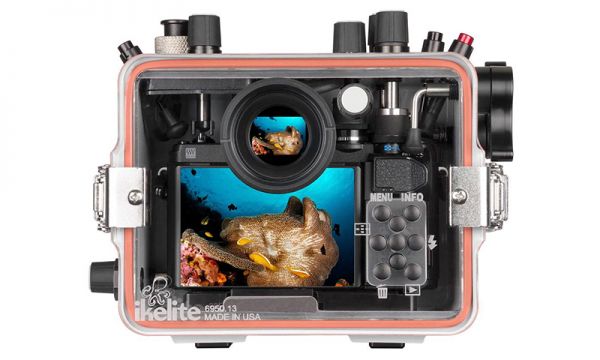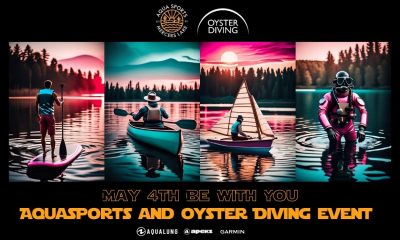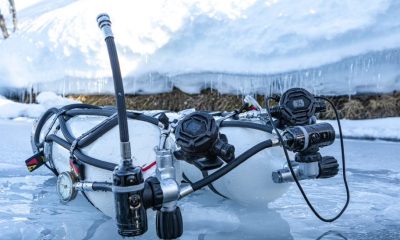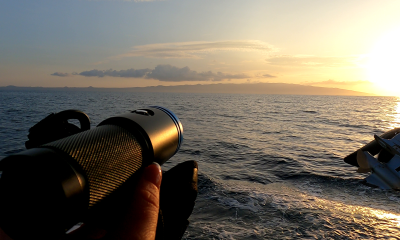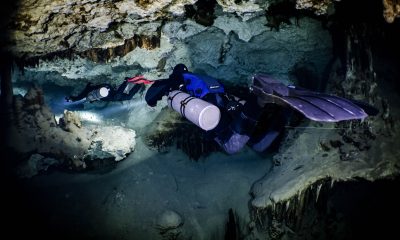News
Ikelite Announces Housing for the Olympus OM-D E-M10 Mark III
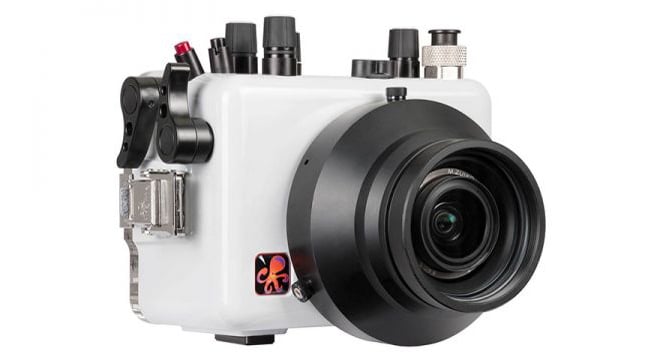
200DLM/A Underwater TTL Housing for Olympus OM-D E-M10 Mark III Mirrorless Micro Four-Thirds Cameras
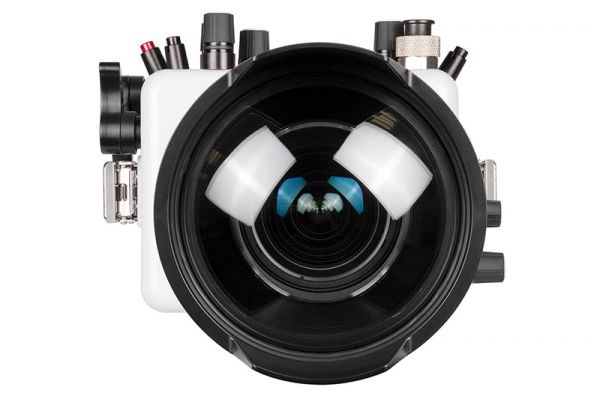 Ikelite has announced its housing for the Olympus OM-D E-M10 MKIII camera which was released in 2017. A professional grade, compact waterproof housing, perfect for any application in or around the water from scuba to surf to pool.
Ikelite has announced its housing for the Olympus OM-D E-M10 MKIII camera which was released in 2017. A professional grade, compact waterproof housing, perfect for any application in or around the water from scuba to surf to pool.
The Olympus OM-D E-M10 Mark III is a powerful compact interchangeable lens camera. Customizable controls, a TTL flash hotshoe, and a titling LCD screen make it a good choice for underwater use. The E-M10 Mark III features a 16MP CMOS sensor, 4K/UHD video at 24p and 30p, and a 121-point contrast-detect AF system.
True TTL exposure
Proper strobe exposure is the #1 most important contributor to sharp and colorful underwater photos, particularly below 30ft/10m. This is the only housing to include an integrated TTL circuit fine-tuned to the Olympus O-MD E-M10 Mark III flash exposure protocol for the fastest and most accurate exposure possible. TTL communication by electrical sync cord improves camera battery life and recycle time, meaning you get many times more strobe-lit shots when you need them. The TTL circuit is powered by the strobe for zero maintenance and no batteries to change. Exposure compensation in TTL mode is supported using the camera’s built-in control. At this time, only Ikelite DS strobes are capable of powering the TTL circuitry. Non-Ikelite strobes featuring an electrical bulkhead may be attached by sync cord but must be used in manual exposure modes only.
Built-in Flash
The camera’s built-in flash may be used to trigger external fiber optic strobes. Two fiber optic ports are provided on the top of the housing for attachment of compatible fiber optic cords (see compatibility information below). The built-in flash is not suitable for lighting a subject underwater.
Constant-On Lighting
A bright constant-on video light can be used instead of or in addition to a flash. A constant-on light is not as bright as a strobe flash. Constant-on lights do provide added versatility because they can be used for focus assist and for improved colors when shooting video. Light is absorbed as it travels through even short distances underwater, making colors appear dull or monochromatic. To preserve the natural colors of your subject, it’s important to stay within arm’s reach—no more than 3-4 feet (1m) away. There is a simple rule that brighter is better underwater. A high-quality lighting system can produce magazine quality results with almost any camera system.
Extensive Lens Support
High quality yet affordable optics are available for an extensive range of micro four-thirds lenses from wide angle fisheye to macro. The DLM port system is designed to be tough enough for heavy surf and without complex mechanisms for supreme reliability in remote locations. The custom optical grade acrylic domes provide the color, clarity, and durability of glass at a fraction of the travel weight and cost. Glass flat ports are available for macro lenses. Lens port sold separately. A compatible lens port is required for waterproof use.
Controls and Ergonomics
 A trigger-type shutter lever control is designed for optimal sensitivity and a natural motion when shooting underwater. The standard control hugs the side of the housing for comfortable use when hand holding. The AEL/AFL button is accessed by a lever for convenient access to customizable functions. Try using back button focus via the AFL button for shooting small or fast moving subjects. Both shutter and AEL/AFL / Fn1 levers can be easily extended using the optional Shutter Trigger Extension # 4077.93 for more comfortable reach when using a handle grip. Soft-touch knobs are easy to grip with or without gloves on and provide quick access to important controls including front and rear dials and the mode control. Hard anodized aluminum push buttons are extremely lightweight and resistant to salt build-up and corrosion. The video record start/stop button is bright red anodized to stand out so that you never miss the action. The back of the housing features laser engraved control symbols which will never fade or fall off.
A trigger-type shutter lever control is designed for optimal sensitivity and a natural motion when shooting underwater. The standard control hugs the side of the housing for comfortable use when hand holding. The AEL/AFL button is accessed by a lever for convenient access to customizable functions. Try using back button focus via the AFL button for shooting small or fast moving subjects. Both shutter and AEL/AFL / Fn1 levers can be easily extended using the optional Shutter Trigger Extension # 4077.93 for more comfortable reach when using a handle grip. Soft-touch knobs are easy to grip with or without gloves on and provide quick access to important controls including front and rear dials and the mode control. Hard anodized aluminum push buttons are extremely lightweight and resistant to salt build-up and corrosion. The video record start/stop button is bright red anodized to stand out so that you never miss the action. The back of the housing features laser engraved control symbols which will never fade or fall off.
Camera Installation
The camera mount is front-loading for easy installation and removal. A small mounting plate attaches to the bottom of the camera and secures in the front of the housing. The camera mounting plate does not need to be removed from the camera for surface use or when changing the battery or memory cards. The mounting plate features a 1/4-20 threaded mount on the bottom so that it can be attached to a tripod on the surface.
Viewfinders
The included Supereye Viewfinder provides an enhanced view of the camera’s optical viewfinder when viewed through a dive mask. Get the brightest and sharpest view of the camera’s OLED EVF by adding an optional Magnified Viewfinder. The Supereye removes quickly and easily for the attachment of an Straight Magnified Viewfinder # 6890 or 45° Magnified Viewfinder (Type 1) # 6891.1. The camera’s large, super-bright LCD screen is viewable through the back of the housing and can be tilted prior to installation in the housing for a a better view underwater.
Accessory Mounting
Two 1/4-20 threaded mounting points are included on the bottom of the housing for the attachment of a tray and handle grips. Handles provide improved ergonomics underwater and are the foundation for your lighting mounts. If you’re shooting with two strobe or lighting arms, then a top handle can be added to carry to and from the dive site. Top handles are available in a Cable Grip # 4080.07 or Aluminum Top Handle # 4080.08. The rigid aluminum version provides additional mounting points for lighting and accessories.
Sealing and Testing
There is no greater assurance than being able to see your camera and o-ring seal through the back of the housing. Our signature open-groove design suspends the rear o-ring in a natural position that is easier to maintain and more reliable than forcing the o-ring into a channel. Once the housing is closed you can see the o-ring form a solid, waterproof seal. A spare 1/2-20 threaded accessory port is provided on the side of the housing for easily installation of the optional Vacuum Kit # 47012. A hand pump with gauge allows you to draw a vacuum on the housing to simulate water pressure and check for leaks prior to entering the water. Every unit is water pressure tested to 200 feet (60m) before it leaves the facility in Indianapolis.
Durability and Corrosion Free Performance
A custom ABS-PC blend housing provides strength and performance year after year with minimal maintenance. The ABS-PC material is fundamentally corrosion-proof and considerably lighter than aluminum. The specially formulated color deflects the sun to keep your camera running cooler, longer. Compared to black or clear housings, the light color provides superior contrast for enhanced view of the camera, LCD screen, and o-ring seal.
Optional Accessories
- Spare Rear O-Ring # 0110 Carry a back-up in case original seal becomes damaged.
- Spare Front O-Ring # 0132.45 Carry a back-up in case original seal becomes damaged.
- Vacuum Kit for 1/2″ Accessory Port # 47012 Check for leaks prior to entering the water.
- Tray with Dual Quick Release Handles # 9523.64 Add a tray for easier handling and a second attachment point for strobes or lights.
- Shutter Trigger Extension # 4077.93 Brings shutter and/or AEL/AFL / Fn1 lever out to handle for more comfortable use.
- 45º Magnified Viewfinder (Type 2) # 6891.1 Brighter, larger, and more ergonomic positioning when shooting under water. Rotates for landscape or portrait shots.
- Adding an external strobe or video light enhances your photos’ color and sharpness underwater. If you will be shooting below 30 ft (10m) or in an indoor pool, your photos will be predominantly blue-green without an artificial light source. Read more about strobe options
Specifications
- 200 ft (60m) depth rating
- DLM/A port mount
- Controls for all important camera functions
- Ikelite flash bulkhead connector with built-in TTL circuitry
- Two 1/4-20 threaded tray mounts with 3″ (76mm) spacing
- Slightly negative buoyancy in fresh water
- Actual buoyancy varies depending on choice of lens and port
- 3.7 lb (1691 g)
- 7.37 x 6 x 5.5″ (187 x 152 x 139 mm)
- ABS-PC, acrylic, and acetyl construction
For more information
Blogs
Northern Red Sea Reefs and Wrecks Trip Report, Part 2: Wall to Wall Wrecks

Jake Davies boards Ghazala Explorer for an unforgettable Red Sea diving experience…
The second day’s diving was a day full of wreck diving at Abu Nuhas, which included the Chrisoula K, Carnatic, and Ghiannis D. The first dive of the day was onto the Chrisoula K, also known as the wreck of tiles. The 98m vessel remains largely intact where she was loaded with tiles which can be seen throughout the hold. The stern sits at 26m and the bow just below the surface. One of the highlights of the wreck is heading inside and seeing the workroom where the machinery used for cutting the tiles are perfectly intact. The bow provided some relaxing scenery as the bright sunlight highlighted the colours of the soft coral reef and the many reef fish.

Following breakfast, we then headed to the next wreck, which was the Carnatic. The Carnatic is an 89.9m sail steamer vessel that was built in Britain back in 1862. She ran aground on the reef back in 1869 and remains at 27m. At the time, she was carrying a range of items, including 40,000 sterling in gold. An impressive wreck where much of the superstructure remains, and the two large masts lay on the seafloor. The wooden ribs of the hull provide structures for lots of soft corals, and into the stern section, the light beams through, bouncing off the large shoals of glass fish that can be found using the structure as shelter from the larger predators that are found outside of the wreck.

The final wreck at Abu Nuhas was the Ghiannis D, originally called ‘Shoyo Maru,’ which was 99.5m long and built in Japan back in 1969 before becoming a Greek-registered cargo ship in 1980. The ship then ran aground on the reef on April 19th, 1983, and now sits at the bottom at a depth of 27m. Heading down the line, the stern of the ship remains in good condition compared to the rest of the hull. The highlight of the wreck, though, is heading into the stern section and down the flights of stairs to enter the engine room, which remains in good condition and is definitely worth exploring. After exploring the interior section of the ship, we then headed over to see the rest of the superstructure, where it’s particularly interesting to see the large table corals that have grown at the bow relatively quickly considering the date the ship sank. After surfacing and enjoying some afternoon snacks, we made sure everything was strapped down and secured as we would be heading north and crossing the Gulf of Suez, where the winds were still creating plenty of chop.

The next morning, it was a short hop to Ras Mohammed Nature Reserve for the next couple of days of diving. The 6am wake-up call came along with the briefing for the first site we would be diving, which was Shark & Yolanda. The low current conditions allowed us to start the dive at Anemone City, where we would drift along the steep, coral-filled wall. These dives involved drifts, as mooring in Ras Mohammed wasn’t allowed to protect the reefs. As a dive site, Shark & Yolanda is well-known and historically had a lot of sharks, but unfortunately not so many in recent years, especially not so early in the season. However, there was always a chance when looking out into the blue.

The gentle drift took us along the steep walls of the site, with plenty of anemone fish to be seen and a huge variety of corals. It wasn’t long into the dive before we were accompanied by a hawksbill turtle, who drifted with us between the two atolls before parting ways. Between the two reefs, the shallow patch with parts of coral heads surrounded by sand provided the chance to see a few blue-spotted stingrays that were mainly resting underneath the corals and are always a pleasure to see. With this being the morning dive, the early sunlight lit up the walls, providing tranquil moments. Looking out into the blue, there was very little to be seen, but a small shoal of batfish shimmering underneath the sunlight was a moment to capture as we watched them swim by as they watched us.

Towards the end of the dive, we stopped at the wreck of the Jolanda where the seafloor was scattered with toilets from the containers it was carrying. This provided a unique site to make a safety stop, which was also accompanied by a large barracuda slowly swimming by, along with a hawksbill turtle calmly swimming over the reef as the sun rays danced in the distance.
For the next dive, we headed north to the Strait of Tiran to explore the reefs situated between Tiran Island and Sharm El Sheik, which were named after the British divers who had found them. We started on Jackson before heading to Gordons Reef, where we also did the night dive. All the atolls at these sites provided stunning, bustling coral reefs close to the surface and steep walls to swim along, which always provided the opportunity to keep an eye out for some of the larger species that can be seen in the blue. Midwater around Jackson Reef was filled with red-toothed triggerfish and shoals of banner fish, which at times were so dense that you couldn’t see into the blue. Moments went by peacefully as we enjoyed the slow drift above the reef, watching these shoals swim around under the mid-afternoon sun.

The night dive at Gordon’s Reef was mainly among the stacks of corals surrounded by sand, which was great to explore under the darkness. After some time circling the corals, we came across what we were really hoping to find, and that was an octopus hunting on the reef. We spent the majority of the dive just watching it crawl among the reef, blending into its changing surroundings through changes in colour and skin texture. It’s always so fascinating and captivating to watch these incredibly intelligent animals, in awe of their ability to carry out these physical changes to perfectly blend into the reef. Before we knew it, it was time to head back to the boat to enjoy a well-deserved tasty dinner prepared by the talented chefs onboard.
Check in for the 3rd and final part of this series from Jake tomorrow!
To find out more about the Northern Red Sea reef and wrecks itineraries aboard Ghazala Explorer, or to book, contact Scuba Travel now:
Email: dive@scubatravel.com
Tel: +44 (0)1483 411590
Photos: Jake Davies / Avalon.Red
Marine Life & Conservation
Double Bubble for Basking Sharks

 The Shark Trust is excited to announce that, for two more days only, all donations, large or small, will be doubled in the Big Give Green Match Fund!
The Shark Trust is excited to announce that, for two more days only, all donations, large or small, will be doubled in the Big Give Green Match Fund!
Donate to Basking in Nature: Sighting Giants
The Shark Trust is hoping to raise £10k which will be doubled to £20k. This will go towards Basking in Nature: Sighting Giants. And they need YOUR help to reach they’re goal.
The Shark Trust’s citizen science project is to monitor and assess basking sharks through sightings; encouraging data collection, community engagement, and promoting nature accessibility. This initiative aims to enhance health and wellbeing by fostering a deeper connection with British Sharks.
Campaign Aims
- Increase citizen science reporting of Basking Sharks and other shark sightings to help inform shark and ray conservation.
- Provide educational talks about the diverse range of sharks and rays in British waters and accessible identification guides!
- Create engaging and fun information panels on how to ID the amazing sharks and rays we have on our doorstep! These can be used on coastal paths around the Southwest. With activities and information on how you can make a difference for sharks and rays!
- Promote mental wellbeing through increasing time in nature and discovering the wonders beneath the waves!
Donate, and double your impact. Click Here
-

 News3 months ago
News3 months agoHone your underwater photography skills with Alphamarine Photography at Red Sea Diving Safari in March
-

 News3 months ago
News3 months agoCapturing Critters in Lembeh Underwater Photography Workshop 2024: Event Roundup
-

 Marine Life & Conservation Blogs2 months ago
Marine Life & Conservation Blogs2 months agoCreature Feature: Swell Sharks
-

 Blogs2 months ago
Blogs2 months agoMurex Resorts: Passport to Paradise!
-

 Blogs2 months ago
Blogs2 months agoDiver Discovering Whale Skeletons Beneath Ice Judged World’s Best Underwater Photograph
-

 Gear Reviews2 months ago
Gear Reviews2 months agoGear Review: Oceanic+ Dive Housing for iPhone
-

 Marine Life & Conservation2 months ago
Marine Life & Conservation2 months agoSave the Manatee Club launches brand new webcams at Silver Springs State Park, Florida
-

 News3 months ago
News3 months agoWorld’s Best Underwater Photographers Unveil Breathtaking Images at World Shootout 2023


